

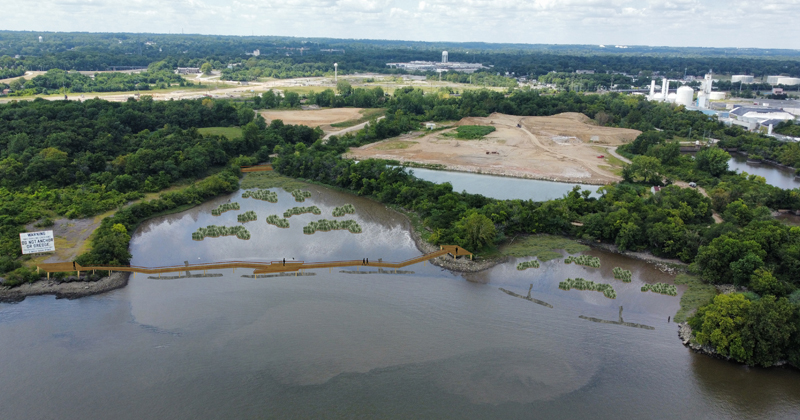
Reconnecting Claymont to the Delaware River
Photos courtesy of the Coastal Resilience Design Studio and the Hagley Museum and Library October 20, 2023
Coastal Resilience Design Studio students created conceptual plan that helped Claymont receive $1.5 million grant
Throughout its history, Claymont, Delaware, has had a special connection to the waters of the Delaware River. Located near the mouth of Naamans Creek in the northeast corner of Delaware, Claymont has been occupied since at least 1200 A.D., according to the Claymont Historical Society. The creek is named after the chief of the Lenape, the Indigenous people who inhabited present-day Delaware, New Jersey, eastern Pennsylvania and Hudson Valley, New York.
But when two major highway projects — I-95 and I-495 — began in the early 1960s, Claymont suddenly found itself separated from the water.
Reconnecting Claymont to the water, and infusing the census-designated place with more green spaces, has been a refrain from the community that Delaware House Representative Larry Lambert has heard frequently — both from growing up and living in the community and serving on the board of the Claymont Renaissance Development Corporation (CRDC).
So when a 300-plus-acre site near the river that was once home to a steel mill and is now owned by the Commercial Development Company opened up for a redevelopment plan, Lambert said that getting a riverfront park was one of the community’s main priorities.
“One thing that has always been consistent when we got community input on what they would like to see [in the area] is a riverfront park,” Lambert said. “Getting a riverfront park is us delivering to the community what the community asked for.”
Having grown up in Claymont, Lambert said he remembers hearing stories from older residents about how they used to go down to the water and fish. When he was a teenager himself, Lambert and his friends found creative ways to navigate from Claymont down to the river.
“You can clearly see when you go down there that at some point, the community likely did have access to this riverfront,” Lambert said. “So that’s what we’re trying to do. We’re trying to return Claymont back to what it once was.”
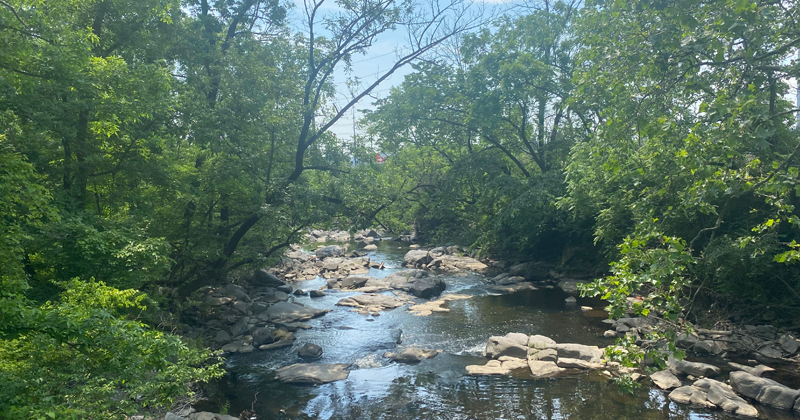
In order to get funding for a riverfront park, however, Claymont needed a conceptual design that could show off the park’s potential, including social, economic and environmental benefits.
That’s where the University of Delaware and students from the Coastal Resilience Design Studio (CRDS) stepped in.
Using the former steel site as a starting point for the park, and using the community’s input gathered from the North Claymont Area Master Plan, which held a series of three community workshops conducted in 2017 by the Wilmington Metropolitan Area Planning Council (WILMAPCO), the students in the CRDS were able to put together a Riverfront Park Conceptual Plan for Claymont.
Through Lambert, that design eventually found its way to the Bezos Family Foundation and helped secure a $1.5 million grant from the Bezos Earth Fund’s Greening American Cities initiative.
Professional Design
Brett Saddler, executive director of the CRDC, was emphatic in his praise of the design put together by the CRDS students and said that without the design, it might not have been possible to get the Bezos grant.
“We were looking for a way to put together a concept design for the park, but we didn’t have the resources to hire a design firm,” Saddler said. “Unless you have a visual representation to show how we’re going to make this happen, the idea is not going to get any traction. It’s just going to be this vague idea floating out there in the ether.”
Philip Barnes, assistant professor and policy scientist at UD’s Joseph R. Biden Jr., School of Public Policy and Administration’s Institute for Public Administration who also serves on the board of the CRDC, suggested to Saddler that the CRDS might be able to put together a plan. Saddler said when he received the students’ final project, he was impressed by how professional it looked.
“When I got a copy of the draft, I was floored,” Saddler said. “I thought it was as good as anything that we would have spent $50,000 on — minimum — for a concept plan from a professional design firm. We’re ready to hit the ground running to continue fundraising, and we have that leg up because we have a great plan done by the UD students as a concept.”
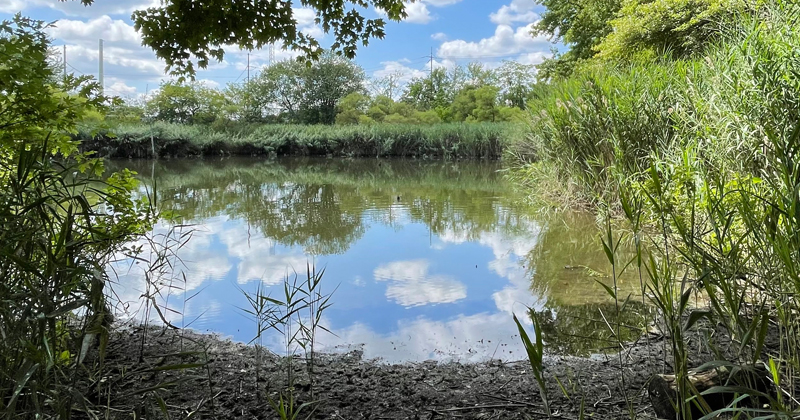
CRDS Plan Conceptualized
The plan aimed to create a space that provided recreational opportunities for the community, such as riverfront access, trails, sports fields, an event space and a marina. This plan would also help to enrich Claymont’s regional profile and offer resilient solutions to ensure the longevity and vibrancy of the development in the face of a changing environment.
Jules Bruck, an affiliated faculty member at UD and director of the University of Florida’s School of Landscape Architecture and Planning, said the CRDS was happy to partner with the CRDC and other partners involved with the project, including Delaware Greenways, the East Coast Greenway Alliance and Delaware Sea Grant (DESG). In partnering with the East Coast Greenway Alliance, the plan looked to create connectivity with the East Coast Greenway, which consists of 3,000 miles of trails from Maine to Florida across 15 states.
The CRDS, a partnership between the Delaware Sea Grant College Program, the University of Delaware Sustainable Coastal Communities Initiative and the University of Delaware Landscape Architecture Program, was led by Bruck, DESG coastal communities development specialist Ed Lewandowski, and Ben Muldrow of Arnett, Muldrow, LLC, at the time the project was completed.
Lewandowski said it was a special feeling to have the opportunity to put together a plan for the town that he grew up in.
“I’m a product of Claymont. My father worked at the old steel mill, and the property along the riverfront represented an opportunity for a multitude of outdoor discoveries during my childhood,” Lewandowski said.
Students involved in the project came from UD, Penn State University, Northwestern University and Wilmington University. The two UD students who worked on the project were Ryan McCune, a 2022 environmental engineering graduate, and Delaney Pilotte, a 2023 landscape architecture graduate.
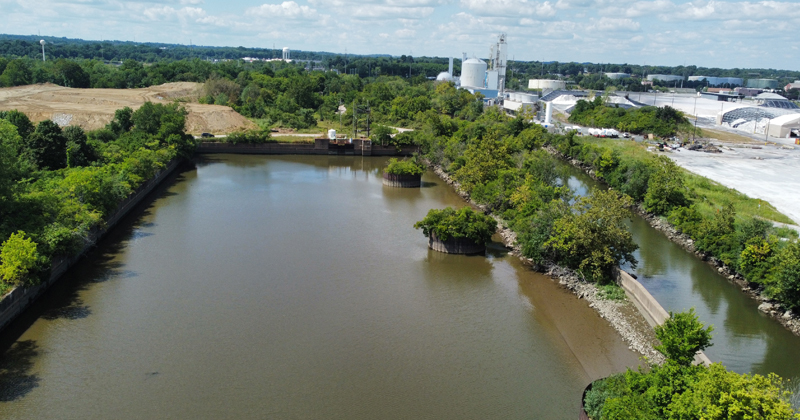
As for the overall goal of the design, Bruck explained that they were using community input to try to best meet the needs of the Claymont residents.
“We were looking to provide recreational opportunities for the community and how people from the community could access river fronts through trails, maybe put in sports fields or event space, and even a marina,” Bruck said. “Then, we wanted to establish connectivity to all the surrounding communities and enhance Claymont’s regional profile.”
As Claymont is also getting a new SEPTA train station and DART Transit Hub, which is expected to be operational in the fall of 2023, the CRDS was also working its design around the new station.
In addition, Bruck said it was important for the CRDS to do a coastal site analysis to ensure that the park would be viable now and in the future.
“Overall, all of our projects are about designing resilient solutions to make sure that they will live on during a time of changing environments,” Bruck said. “We did a site analysis to try to understand what the coast had to offer, and in terms of sea-level rise, of how things were going to change over time. We also looked at transportation units and where the transportation system was going, and we tried to understand the residents’ concerns to get at their sense of place. Once we had that information, we determined the design goals.”
Gainey, who has worked on many CRDS projects, said he is always amazed at how a diverse group of students from backgrounds including landscape architecture, civil engineering and environmental engineering can come together and create a cohesive design plan.
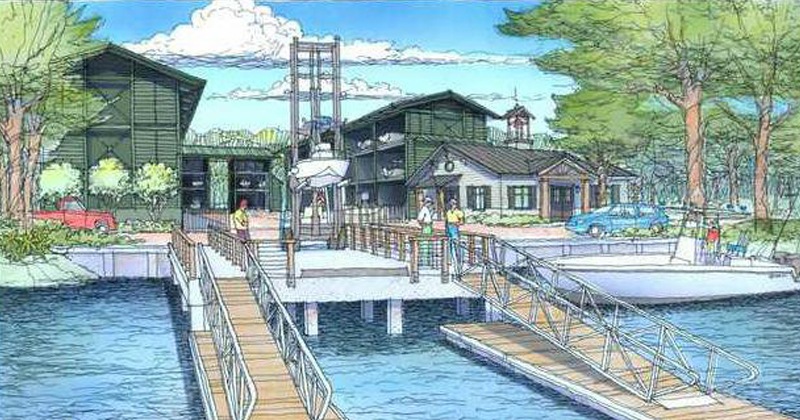
“When doing the project, we imagined the waterfront park as an opportunity to link the surrounding communities and provide opportunities where we found gaps — such as the conditions and proximity of the parks surrounding the Claymont area at the time,” Gainey said.
Having the chance to design a park in an area formerly used for industrial purposes was also appealing to Gainey, and he said that he enjoyed the opportunity to create a park that would benefit the Claymont community now and in the future.
“Along with creating the opportunity to promote community building, there is inherent value in the many features of our design that foster economic and human-based growth through visitors and presenting a suitable park that addresses the feedback received locally and incorporates sustainable growth,” Gainey said. “One thing I've enjoyed greatly about projects like this one is identifying creative ways to incorporate direct feedback from the local community in ways that feed off the CRDS team's many disciplines.”
With the initial plan completed, and the Bezos’ funds in-hand, the next step is to raise additional funds to take the riverfront park from a concept to reality.
“This will be a deliberate process that will take years, and we appreciate everyone’s patience,” Lambert said. “But as you can see, we’re taking meaningful steps. For me, it’s really about the ‘we.’ It’s about the ‘us.’ That is what Claymont is about. Claymont is about solidarity. It’s about looking out for your brother and sister. Claymont is a strong, vibrant town, and we’re always making sure that we listen to each other. Together, our impacted communities, we’re going to keep working hard until we make sure that we return access to those green spaces and to the river.”
Contact Us
Have a UDaily story idea?
Contact us at ocm@udel.edu
Members of the press
Contact us at 302-831-NEWS or visit the Media Relations website

